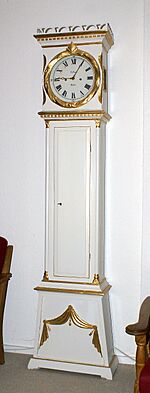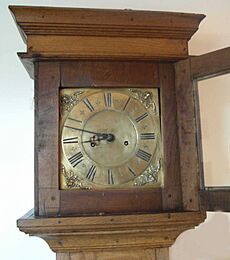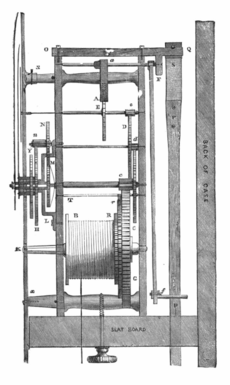Grandfather clock facts for kids
A grandfather clock is a very tall, freestanding clock. People also call it a longcase clock or tall-case clock. These clocks use a swinging part called a pendulum and heavy weights to keep time. The pendulum hangs inside the clock's tall case.
Most grandfather clocks are about 1.8 to 2.4 meters (6 to 8 feet) tall. Their pendulums and weights are hidden inside the case. These weights hang from cables or chains. You need to adjust them sometimes to keep the clock accurate. The top part of the clock, called the hood, often has fancy carvings. This hood frames the clock's face.
An English clockmaker named William Clement helped create this clock style in 1670. For a long time, pendulum clocks were the most accurate way to tell time. Grandfather clocks were especially good at this. They often served as the main timekeepers for homes and businesses. Today, people mostly keep them for their beautiful look and antique value. Modern analog and digital clocks have taken their place for everyday timekeeping.
Contents
Why Are They Called Grandfather Clocks?
The popular name "grandfather clock" comes from a song. It's from the 1876 song My Grandfather's Clock. The Oxford English Dictionary says this song made the name famous.
An American songwriter, Henry Clay Work, wrote the song. He found a longcase clock in a hotel in England. He learned that the clock had two owners. When the first owner died, the clock started to lose time. When the second owner died, the clock stopped completely. This story inspired Henry to write his famous song.
Grandfather clocks are usually at least 1.9 meters (6.2 feet) tall. There are also "grandmother" and "granddaughter" clocks. These are similar but a bit shorter.
How Grandfather Clocks Started
The longcase clock became possible because of a new invention. This was the anchor escapement mechanism. Robert Hooke invented it around 1658. This part made the pendulum swing much smaller. It swung only about 4 to 6 degrees. This allowed clockmakers to use longer pendulums.
Longer pendulums swung slower and used less power. This meant clocks could run longer between windings. They also had less wear and were more accurate. Most longcase clocks use a "seconds pendulum". This means each swing takes exactly one second. These pendulums are about 1 meter (3.3 feet) long. This length requires a tall, narrow case.
The tall case itself appeared a few decades before the anchor clock. It was first used around 1660. This was to allow enough space for the long weights to drop. But once the seconds pendulum was used, the tall case was perfect for it too.
British clockmaker William Clement made the first longcase clocks by 1680. Later that same year, Thomas Tompion also started making them. Tompion was a very famous British clockmaker. Longcase clocks quickly became popular. They spread from England to other European countries and even to Asia.
Early longcase clocks, like all clocks before the anchor escapement, had only one hand. They showed only the hour hand. The new accuracy from the anchor mechanism changed this. The minute hand was added to clock faces in the following decades.
Between 1680 and 1800, a grandfather clock in England cost about £1 10s. In 1680, this was a lot of money. It was about a year's rent for an average working family. So, only wealthy people could buy clocks then. But by 1800, wages had gone up. Many middle-class families could then afford grandfather clocks.
Modern longcase clocks use an even more accurate anchor escapement. It's called the deadbeat escapement.
How Grandfather Clocks Work

Traditionally, longcase clocks had two main types of inner workings. These were eight-day and one-day (30-hour) movements. An eight-day clock only needed winding once a week. The less expensive 30-hour clocks had to be wound every day.
Eight-day clocks often have two weights. One weight powers the pendulum. The other powers the striking mechanism. This mechanism usually rings a bell or plays chimes. These clocks usually have two keyholes on the dial. You use them to wind each weight.
Thirty-hour clocks often had just one weight. This weight powered both the timekeeping and the striking parts. Some 30-hour clocks even had fake keyholes. This was for owners who wanted guests to think they owned a more expensive eight-day clock. Today, all modern striking longcase clocks have eight-day movements. They chime every quarter hour and strike the full hour.
Most longcase clocks are "cable-driven." This means cables hold up the weights. The cable wraps around a pulley on top of each weight. This setup doubles the running time for a given weight drop. You wind cable clocks by inserting a special crank, called a "key," into holes on the clock's face and turning it.
Other clocks are "chain-driven." Here, chains hold the weights. The chains wrap around gears inside the clock. The other end of the chain hangs down next to the weight. To wind a chain-driven clock, you simply pull on the end of each chain. This lifts the weights until they are just under the clock's face.
The world's tallest grandfather clock is huge. It stands 35 feet 10 inches (10.9 meters) tall. It works perfectly and chimes every quarter hour. Svoboda Industries made it in 1976. This was a project for the United States Bicentennial. You can find it in Kewaunee, Wisconsin.
Chimes and Sounds of Grandfather Clocks
In the early 1900s, quarter-hour chime sequences were added to longcase clocks. A full chime sequence plays at the top of each hour. Then, the clock immediately strikes the hour.
- At 15 minutes past the hour, 1/4 of the chime sequence plays.
- At 30 minutes past the hour, 1/2 of the chime sequence plays.
- At 45 minutes past the hour, 3/4 of the chime sequence plays.
The most common chime tune is Westminster Quarters. Many clocks also let you choose other tunes. These include Whittington chimes or St. Michael's chimes. There's usually a switch on the side of the dial to select the tune. You can also use this switch to turn off the chimes if you want. Because of these chime sequences, all modern mechanical longcase clocks have three weights.
- The left weight powers the hour strike.
- The middle weight powers the clock's pendulum and keeps time.
- The right weight powers the quarter-hour chime sequences.
Different Styles of Grandfather Clocks
Comtoise Clocks
Comtoise clocks are also known as Morbier clocks or Morez clocks. They are a special style of longcase clock. They were made in the Franche-Comté region of France. This is where their name comes from. These clocks have a unique "potbellied" case. They also use a lot of curved lines. A heavy, long, and very decorated pendulum bob often extends up the case.
People started making these clocks in 1680. Production continued for about 230 years. At their busiest, from 1850 to 1890, over 60,000 clocks were made each year. These clocks were very popular for many generations. They kept time on farms all over France. You can find many Comtoise clocks in France. They are also common in Spain, Germany, and other parts of Europe. Fewer are found in the United States. Many Comtoise clocks were also sent to other countries. This included the Ottoman Empire and even as far as Thailand. A wooden cover usually protected the metal parts during shipping.
Bornholm and Mora Clocks

Bornholm clocks are Danish longcase clocks. They were made on the island of Bornholm from 1745 to 1900. In Sweden, a special type of longcase clock was made in Mora. These are called Mora clocks.
Bornholm clock-making started in the 1740s. An English ship carrying longcase clocks got stuck near the island. The clocks were sent for repair to a turner named Poul Ottesen Arboe in Rønne. By repairing them, he learned enough to start making his own clocks.
Famous Grandfather Clock Makers
Many clockmakers have made grandfather clocks throughout history. Here are some of the most well-known:
British Clockmakers
- John Alker of Wigan
- William Barrow, London
- Bilbie family, Somerset
- John Harrison, Wakefield/Barrow upon Humber/London
- Timothy Mason, Gainsborough, Lincolnshire
- Daniel Quare
- James Woolley Codnor
Irish Clockmakers
Finnish Clockmakers
- Masters of Könni (1757–1865), Ilmajoki
American Clockmakers
- Ansonia Clock Company (1851–2006), Ansonia, Connecticut
- Benjamin Bagnall (1689–1773), Boston
- Isaac Brokaw (1746–1826), Bridge Town, New Jersey
- Simon Willard (1753–1848), Roxbury, Massachusetts
Australian Casemaker
- Harry Williams – Oxford Cabinet Company Pty Ltd (1946–1961), Granville, New South Wales, Australia
Modern Grandfather Clock Makers
Some companies still make grandfather clocks today:
- Hermle Clocks – Amherst, VA
- Howard Miller Clock Company – Zeeland, MI
- Ridgeway Clocks (now owned by Howard Miller Clock Co.)
- Seth Thomas Clock Company - (reopened under the Colibri Group)
See also
 In Spanish: Reloj de abuelo para niños
In Spanish: Reloj de abuelo para niños








